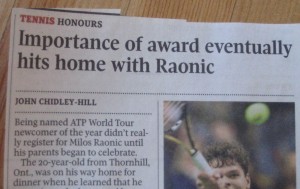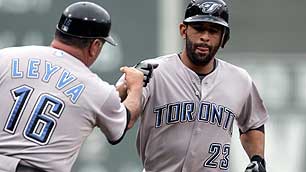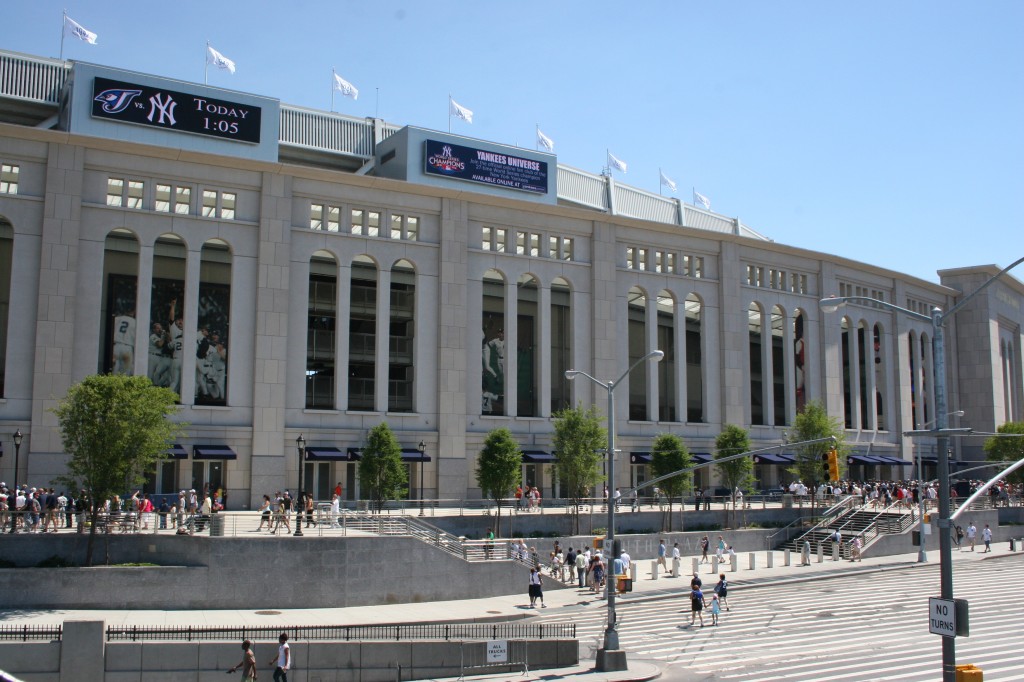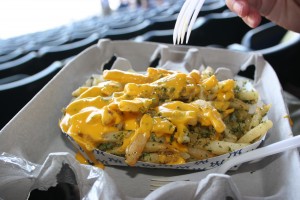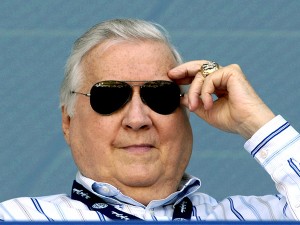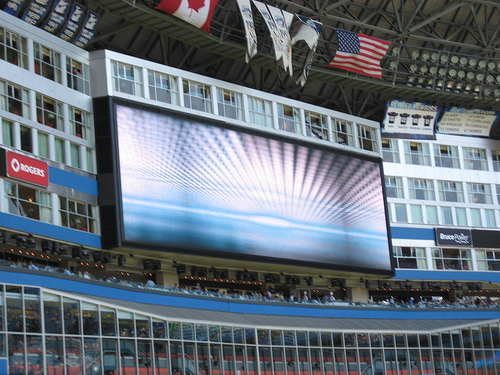A rare double billing on bylines
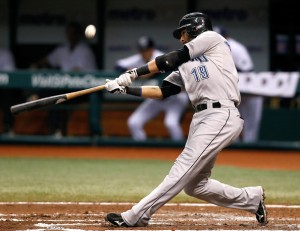 There are days on the People’s Wire – that’s The Canadian Press to you – that are really quiet, where we focus on Canadianizing stories from the Associated Press and crafting small, quick stories of our own.
There are days on the People’s Wire – that’s The Canadian Press to you – that are really quiet, where we focus on Canadianizing stories from the Associated Press and crafting small, quick stories of our own.
But then there are days like yesterday when we live on the phone, recording conference calls, working from news releases and hunting down stories.
Over the weekend Milos Raonic was named the ATP Tour’s Newcomer of the Year. I put together a story on it and contacted Tennis Canada to ask if they’d have any media availability with the Thornhill, Ont., native.
Raonic wasn’t immediately available, but the PR person assured me he’d have a conference call on yesterday.
Sure enough, when I came in to work my boss Neil Davidson had printed off Tennis Canada’s notice about Raonic’s availability. I hopped on the call, rolling tape for radio stations on our broadcast wire and to refer to for colour on this story.
It took a few drafts, but we got the Raonic story to a good place and it started spreading across the Internet.
It was soon overshadowed though. The American League’s Most Valuable Player was named yesterday afternoon, with starting pitcher Justin Verlander of the Detroit Tigers – already the AL’s Cy Young winner for the season – getting the nod from the Baseball Writers’ Association of America.
Verlander beat out Boston Red Sox fielder Jacoby Ellsbury and Toronto Blue Jays right-fielder Jose Bautista.
Oddly, Bautista decided to hold a news conference from his home in the Dominican Republic.
It was a strange move because, usually, pro athletes quietly nod and say “so-and-so had a great season” when they miss out on major awards. They may be pissed, but they hide that disappointment from the media for fear of looking like a sore loser.
Not Bautista, however.
He angrily made a case for why he or Ellsbury should’ve won the MVP award instead of Verlander. Bautista’s two major points were that Verlander didn’t play every day – an implicit qualification for the award – and that he was passed over for the honour because he played for the Blue Jays, a team far out of playoff contention in the fall.
Again, I had to write a full-length feature story (almost 800 words exactly) in just over an hour’s time.
Cranking out two features in a day would be stressful at the best of times, but I was also writing regular broadcast sports bulletins and doing other stories as well. It was a hectic day on the desk.
Naturally, an all-star player like Bautista complaining about an MVP snub made big waves, with several outlets putting the story online. Yahoo Sports’ Jeff Passan even cited the story in one of his stories.
This morning, on a hunch, I bought the print edition of the Globe and Mail, assuming that my Bautista story would make the Toronto edition.
It didn’t – but my Raonic piece did. Here's a photo of the only story that has ever made it onto my fridge door at home.
My latest byline
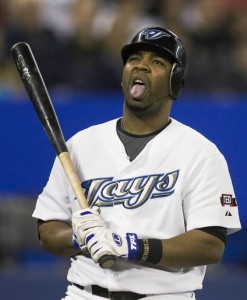 A big part of working desk shifts is listening in on conference calls with athletes, coaches and managers.
A big part of working desk shifts is listening in on conference calls with athletes, coaches and managers.
Today I sat in on a call with Toronto Blue Jays general manager Alex Anthopoulos. The team had set up the call after the Jays signed the club option for infielder Edwin Encarnacion and let relief pitcher Jon Rauch, amongst others, become free agents.
A link to my article is below.
Encarnacion to become utilityman for Jays
TORONTO - Edwin Encarnacion is going to be a jack of all trades for the Toronto Blue Jays next season.
General manager Alex Anthopoulos said Tuesday that the 28-year-old infielder is going to spend more time as a designated hitter and even play some games in the outfield.
"The fact that Edwin can play multiple positions, and now he's going to be playing some left field in winter ball as well, will open up some flexibility," Anthopoulos told a media conference call. "As we sit here today, the role would primarily be DH but we like he can play some first, play some third and we'd like to find out a little bit more about him in left field."
What is the best team in Toronto?
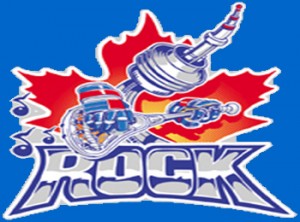 Toronto sports fans are lucky – they live in one of the few cities in North America to have a professional sports team in all four major leagues.
Toronto sports fans are lucky – they live in one of the few cities in North America to have a professional sports team in all four major leagues.
Well, okay, there isn’t really a National Football League team here, but the Buffalo Bills play two games a season at the Rogers Centre and there are the Toronto Argonauts, historically the Canadian Football League’s most successful team. Football is definitely covered in Canada's largest city.
But I digress. Toronto has eight professional sports teams, on a par with, or better than, the 14 American cities that have teams in the NFL, National Basketball Association, Major League Baseball and the National Hockey League.
Unfortunately, this creates a weird competition amongst the teams as they vie for fans attention. I was reminded of this weeks ago when a friend of mine from senior school posted on Facebook “So glad the Leafs suck more than the Raps. At least the Raps have upside”.
Of course, this was before the Raptors embarked on a Cavaliers-esque 13-game losing streak, but the comment got me wondering: what is the best team in Toronto? Which team does the best job of representing a city spoiled for choice?
Here are all of the city’s professional sports franchises, in order of winning percentage over the past two years.
| Team | This season | Last season | Cumulative |
| Rock | .667 (4-2)* | .562 (9-7)† | .615 |
| Blue Jays | .525 (85-77) | .463 (75-87) | .494 |
| Marlies | .470 (24-20-7)* | .413 (33-35-12) | .442 |
| Nationals‡ | .250 (3-9) | .583 (7-9) †¥ | .417 |
| Maple Leafs | .426 (23-26-5)* | .366 (30-38-14) | .396 |
| Raptors | .269 (14-38)* | .488 (40-42) | .379 |
| Argonauts | .500 (9-9-0) † | .167 (3-15-0) | .336 |
| Toronto FC | .300 (9-13-8) | .333 (10-11-9) | .317 |
Notes: * - Season currently underway.
† - Made the playoffs.
¥ - Won championship.
‡ - It was announced in the offseason that the Toronto Nationals have moved to the bustling metropolis of Hamilton, Ont., for 2011.
What’s most apparent in this chart is that it’s good to be a fan of lacrosse in Toronto. Especially if you live in the western part of the Greater Toronto Area, since Major League Lacrosse’s Toronto Nationals – the most recent champions in the city – are moving to nearby Hamilton.
But if you want to see a Toronto-based team do well in the regular season and go deep in to the postseason, you’d better pick up the nuances of lacrosse. The Rock are the best team in the NLL this year after losing a close game in the league championship last season.
Further, six of Toronto’s last nine championships have come from lacrosse teams, with the Rock contributing five and the Nationals bringing home the Steinfeld Cup two summers ago. The other three are all thanks to the Toronto Argonauts winning the Grey Cup in 1996, 1997 and 2004.
It’s also worth noting that attendance is seemingly unaffected by a team’s success.
Most Torontonians would immediately twig to the fact that the Maple Leafs, the city’s fifth best team, remain the most popular franchise while the Blue Jays – ranked second – had serious attendance problems last summer.
But what I find most striking is that Toronto FC, the team with the most passionate fans, has the worst record of Hogtown’s professional sports franchises.
In any event, I think this is an interesting exercise that would test perceptions of Toronto’s sports teams. Tell me: were there any surprises on this chart for you?
Stadium Review: New Yankee Stadium
Visiting Yankee Stadium – the new one, that is – and watching the Pinstrippers host the Toronto Blue Jays was the focal point of my recent trip to the New York City. It was the fourth major league ballpark I’ve ever been to and easily the most awaited.
Opened in 2009, the so-called New Yankee Stadium was built across the street from the original Yankee Stadium. I had tried in vain to get tickets at the elder stadium before it was knocked down, but the only available tickets cost an arm and a leg through scalpers.
I missed out on the House that Ruth built, but did make it to the underwhelming House that Jeter built.
Don’t get me wrong, New Yankee Stadium has a lot going for it.
Architecturally, it’s beautiful. The ballpark stands as a monument to the impressive legacy of Old Yankee Stadium, mimicking many of the original field’s most distinctive qualities and emphasizing that this is the home of the most successful franchise in baseball history.
The architectural team of Populous insured that the dimensions of the field are exactly the same as the old park, although the new seating is slightly smaller the original field at 52,325 (including standing room) versus 56,936.
Also, as you can imagine, the New York Yankees know what they’re doing when staging a baseball game. Every little detail during the game was skilfully handled, from the anthems to the TV timeout features.
Charming touches abounded, especially when the Yankees’ current roster recited Lou Gehrig’s famous speech to commemorate the anniversary of his final game with the club.
And the food, my God, the food. Every stadium has a signature dish. Something that is distinctly theirs. At Yankee Stadium it’s garlic French fries with melted cheese. It’s gooey, salty, cheesey and above all else potent enough to guarantee some space on the subway ride home.
Populous did a lot to emphasize the history of baseball in New York City including moving Monument Park from the older building, creating a Yankee Museum and, of course, a centralized merchandise store off the stadium’s main concourse.
But that’s one of the key problems with New Yankee Stadium.
In their slavish devotion to replicating the style and design of the older building, they did little to improve on the old stadium. Yes, everything is new and shiny but facilities are few and far between.
As a result, there are long lines just about every step of the way. Crowds arrive early, so there is a long wait for most of the features of the park, especially Monument Park, the Yankee Museum and the merchandise outlet.
In fact, the line for Monument Park was cut off an hour and a half before the opening pitch because security personnel needed to be able to clear it out before game time. Same thing with the Yankee Museum – lines had to be cut off because they were so long.
I’ll allow that I went on Independence Day, when most of the crowd was probably from out of town and therefore more likely to go to the touristy corners of the stadium, but surely they could have predicted that those would be crowded sections of the stadium.
Instead, the entrance to Monument Park is in the middle of a cramped corridor. Compared to other contemporary stadiums like cross-town rival Citifield or Detroit’s Comerica Park, which put an emphasis on wide-open space and breezy walkways, it’s a confusing choice.
Ultimately, it’s worth going to Yankee Stadium to say “I’ve been there.” Visitors should expect high prices, long lines and cramped quarters. I would not want to be a Yankees fan and have to attend more than one game per season at that ballpark.
George Steinbrenner will be missed
Earlier today the Associated Press reported that George Steinbrenner, the long-time owner of the New York Yankees, died at the age of 80 after suffering a massive heart attack.
Steinbrenner’s passing was confirmed by the Yankees organization, as well as his family who issued a statement.
“He was an incredible and charitable man,” the Steinbrenners said in their release. “He was a visionary and a giant in the world of sports. He took a great but struggling franchise and turned it into a champion again.”
I wholeheartedly agree with those sentiments. George Steinbrenner was the best owner in baseball, and arguably, in all of professional sports.
Consider the Yankees without the seven World Series championships (2009, 2000, 1999, 1998, 1996, 1978, 1977) they won under his direction. It’s hard to do.
That means no Mr. October, Reggie Jackson.
Derek Jeter, Mariano Rivera, Andy Pettite and Jorge Posada wouldn’t have been the Core Four of the dynasty of the late 1990s and early 2000s.
The New York Yankees, the Evil Empire as we know it, would not have existed without the leadership of the Boss.
Now some may argue that Steinbrenner’s influence damaged the game. As a season ticket holder of the Toronto Blue Jays, I can sympathize. The war of attrition with the Boston Red Sox in the American League East with both teams stockpiling arms like Cold War superpowers has basically ruined any chance of my hometown team winning a pennant.
But that’s a situation that can’t be entirely blamed on Steinbrenner. Major League Baseball made the luxury tax rules, he merely played within their bounds. I can’t say that I blame him. Any owner – any person, for that matter – should pursue success to the fullest extent of their resources.
There’s no point in hating Steinbrenner simply because he had more resources than everyone else.
I’m sure that one of my colleagues in the media is going to write a similar eulogy about how Steinbrenner is the last of a dying breed. How we’ll never see another person make such an impact as the owner of a professional sports team.
Although George Steinbrenner was a unique character, there will be more owners like him. Already in the National Basketball Association we have Mark Cuban and Mikhail Prokhorov, the owners of the Dallas Mavericks and New Jersey Nets respectively, both cast very much in the Steinbrenner mould.
No, I think that Steinbrenner serves as the prototype of what the owner of a professional sports team can be. An ideal example that other owners should model themselves after. He was one of the greats, and although his New York Yankees are often hated, his is a legacy that should be admired.
A fond farewell to Ken Griffey Jr.
Last night was one of those perfect storms of sports news that happens every month or so.
Armando Galarraga’s perfect game was ruined on the 27th out by a controversial call by umpire Jim Joyce.
Game 3 of the Stanley Cup final went into overtime, with a goal being called back after the puck miraculously rolled across the crease. The no-goal was after National Hockey League Commissioner Gary Bettman got cantankerous with Ron MacLean during the second intermission of Hockey Night in Canada.
But what I’ll always remember about June 2nd 2010 is that Ken Griffey Jr. retired.
As I’ve written before, Griffey was my favourite baseball player growing up.
In his prime he was the best fielder and hitter in the game. In a time when professional athletes develop chips on their shoulders, become arrogant or act out, Griffey remained fun-loving and grounded.
His statistics speak for themselves. Griffey accumulated 630 home runs, the fifth-most in baseball history. He has 2781 hits, 1836 RBIs and a career batting average of .284. Hall of Fame numbers to be sure.
Griffey’s best season was undoubtedly 1997 when he won the American League MVP with the Seattle Mariners. That year he hit .304 while reaching career highs with 56 home runs and 147 RBIs.
As impressive as his numbers are, Griffey will always have the aura of unfulfilled potential. Not because he lacked effort, but because he never played in a World Series, even though his Seattle Mariners had a host of talent including Alex Rodriguez, Randy Johnson and Edgar Martinez.
Because he moved to the Cincinnati Reds, a team that has struggled throughout the 1990s and 2000s, he missed out on further playoff opportunities, including two more American League Championship appearances by Seattle in 2000 and 2001.
Nagging injuries forced Griffey to miss prime years of his career. Between 2002 and 2004 he hit a total 41 home runs while playing in only 206 games over those three seasons.
Although Griffey was great, arguably the best of an entire generation of ballplayers, it will always seem as though he might have had still had some untapped potential.
Despite those lost years, Griffey’s career represents an ideal trajectory that in a perfect world all athletes would follow.
Griffey was a genuinely good guy. Griffey knew he was going to be traded from Seattle in 2000, so he asked to be sent to his hometown Cincinnati Reds, the team his father played for in their Big Red Machine glory days. Given the opportunity to abandon the Reds in favour of a bigger salary with the New York Yankees, Griffey took a smaller contract to stay near his family.
He can also be judged for what he didn’t do. In an era where players like Mark McGwire are being held out of Baseball’s Hall of Fame for their connection to performance enhancing drugs, Griffey remains a first-ballot shoe-in because he’s never been connected to any kind of steroid use.
Although Griffey was a shadow of his former self in his final years with the Reds, Chicago White Sox and again with the Mariners, his legacy on and off the field is exemplary of what all baseball players could be – a role model off the field who actually produces incredible numbers.
Griffey will be missed as player, but he will always have a place in baseball.
An open letter to the Toronto Blue Jays
As I’ve mentioned previously, I’ve got a season’s pass for the 500 section of the Rogers Centre for all of the Toronto Blue Jays home games.
This is the fifth season that I’ve had the pass and it’s always a good purchase. The last two years have been particularly enjoyable since the Jays have been very good, particularly in the spring.
However, there’s a problem that creeps up every few games which bugs me. It happened at the last two games I attended and, frankly, I am fed up. So this morning I sent the following email to the Blue Jays:
Dear Blue Jays/Rogers Centre Staff,
I've been a Toronto Star Seasons Pass holder for the past five seasons. I enjoy going to the games and cheering on the Blue Jays.
However, I'm frustrated with my experience at the Rogers Centre and the lack of instant replay on close calls.
This was underscored by the games on Sunday, May 16 and Monday, May 17.
On Sunday John Buck hit a long ball that, from my vantage point in the 500s, looked like a grand slam. However, it was called a ground rule double.
To the umpires’ credit, they went into the dugout to review the play.
Unfortunately, due to the Rogers Centre policy of never showing a close call on the JumboTron, I couldn't see whether or not the officials were making the right call. I was robbed of the chance to judge for myself. I only learned that the umpires had made the correct call when I got home and saw the highlights on TV.
Similarly, at Monday's game, a close call was not shown on the JumboTron.
Lyle Overbay bobbled a throw from Jose Bautista, earning an error. He then threw the ball to third, which sailed past Bautista, earning another error.
Again, thanks to the Blue Jays' short-sighted policy of not showing close calls, I never saw that Overbay had mishandled Bautista's throw.
Instead, I had to rely on this morning's SportsCentre to learn that the umpires had, in fact, made the right call.
These are not the only examples of this frustrating policy, they're just the most recent.
It would do a lot to improve your organization's in-stadium product if you would stop protecting your players and the umpires from the occasional round of heckles.
Please start showing replays of all plays - even if they're close or controversial - because it greatly increases the enjoyment of the game for your audience.
Sincerely,
John
I’ve discussed it with some of my friends and co-workers and have learned that the policy is a passive directive from Major League Baseball’s head office.
The Toronto Star’s Richard Griffin summed it up last Wednesday:
“It is in fact a recommendation from Major League Baseball that teams not show a) close ball-strike replays; b) close plays that may incite the crowd against umpires; and c) plays that are under review i.e. home run calls. Now not every team abides by that rule, although all do on balls and strikes, but the Jays are good, responsible corporate citizens and do not show close calls on the replay board. I disagree because why should fans sitting at home know more about the game than those in the ballpark?”
Obviously, I agree with Griffin’s sentiments.
I would add an important note: In both cases this weekend the umpires had made the correct call. It was close, but they were spot on. Therefore, an instant replay wouldn’t incite the crowd against umpires.
Yes, as a Toronto fan I would have booed because I was frustrated with Overbay’s errors, but I would not have felt any anger toward the umpire for making the right call.
Further, Buck’s ground rule double wouldn’t have caused me to boo at all. He still batted in some runs and gave the Jays the lead. Not as good as a grand slam, but ultimately, there’s nothing to boo there.
If the officials are making objective and correct calls, then the commissioner’s office should have enough confidence to include their fans in what’s happening on the field.
No good can come from leaving your fan base ignorant of what’s going on in the course of a game and MLB as well as its franchises should adjust this rule.
In particular, the Rogers Centre has a beautiful JumboTron that should be put to good use. The Blue Jays should be able to trust their sedate Toronto supporters to not freak out over a controversial call.
The Toronto Blue Jays have dropped the ball
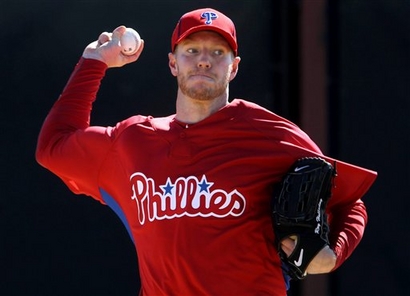 This week is one of those stretches where everything seems to be going on at once in the world of sports.
This week is one of those stretches where everything seems to be going on at once in the world of sports.
Playoffs in the National Basketball Association and the National Hockey League, the world hockey championship and the announcement of World Cup rosters have all garnered headlines in sports sections across the country.
But one piece of news was sure to rankle Canadian sports fans more than the rest – Roy Halladay’s return to the Rogers Centre in late June has been relocated to Philadelphia.
The series was supposed to be a homecoming for the former Jay who is now anchoring the Phillies' rotation.
However, because of a security perimeter set up around the Metro Toronto Convention Centre for the G-20 Summit, Halladay won’t be returning to his old stomping grounds until at least 2011. That is when the Jays and Phillies will next face each other in inter-league play.
Although this year’s series will now be held in Citizens Bank Park, the Blue Jays will still be the home team of record, with the American League’s designated hitter rule in effect and Toronto still getting to hit at the bottom of the inning.
“We would have been bringing people down into an area where people aren’t being asked to come to,” said Blue Jays president and chief operating officer Paul Beeston.
Although safety concerns should be a primary concern of the Toronto franchise’s front office, they could have handled this situation better.
After all, American League rules won’t protect the Blue Jays from Philadelphia’s notoriously obnoxious hecklers. Having the last at bats of the game won’t mitigate the fatigue of travel. It really isn’t an ideal alternative.
The Phillies will also be seeing some kind of profit margin from this change of scenery. Although Beeston insists the endeavour will probably be revenue neutral, I find it hard to believe that the Jays wouldn’t have benefited from a temporary boost in attendance figures.
It would also have been cathartic for a beleaguered Toronto fan base that is still reeling from the loss of Halladay, arguably the greatest player in franchise history.
A better idea would’ve been to put the series at PNC Park, home of the Pittsburgh Pirates. It would still be some distance for Toronto fans to travel, but it would also have been a long drive for the Phillies and their supporters.
Pirates fans would be just as likely to root against their Pennsylvanian rivals as they would be to boo the Blue Jays, so it would eliminate Philadelphia’s home-field fan advantage.
Another logical choice would have been Coca Cola Field, home of the Triple-A Buffalo Bisons. Even closer to Toronto than Pittsburgh, the park has a capacity of 18,025. That’s not up to Major League Baseball’s usual standards, but it would definitely be big enough to hold Toronto’s average crowd of 15,207.
Again, the New York state crowd would be just as apt to heckle the Phillies as they would the Blue Jays.
The move to Philadelphia’s Citizens Bank Park is yet another failure by the Toronto Blue Jays front office to show any kind of respect for its fan base. They could have done better. Done more than just shrug and brush off any concerns at a press conference.
Moving from the Rogers Centre for the duration of the G-20 summit was necessary, but it seems like they put little thought into viable alternatives. Beeston and company have mishandled the situation and done their supporters a disservice.
You’re bringing me down, ARod
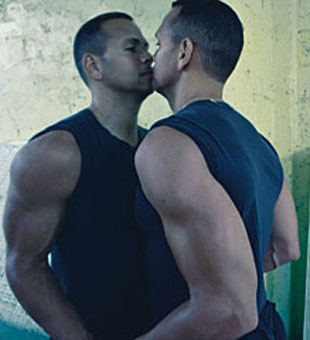
This photo of Alex Rodriguez has nothing to do with Thursday's game against the Oakland Athletics. It's just funny.
Yesterday I tried to be sunny and say three nice things about Major League Baseball. It took less than 24 hours for Alex Rodriguez to bring me back down with his bush league play.
In case you missed it, Yahoo Sports’ Big League Stew summed it up well:
“In the sixth inning of the A's 4-2 victory, Rodriguez went from first to third on a foul ball by Robinson Cano. His trip back to first took him right over the pitcher's mound, an unspoken no-no that ticked [starting pitcher Dallas] Braden off right away.
After a double play ended the inning, the 26-year-old pitcher immediately started yelling at A-Rod — watch it here — who claimed he didn't know he had done anything wrong.”
This isn’t the first time that ARod has broken one of baseball’s unwritten codes. We’ll ignore his admitted steroid use and focus on his transgressions against the game’s etiquette.
My first exposure to Rodriguez’s classless brand of play was during the infamous 2004 American League Championship Series with his New York Yankees leading the series against the Boston Red Sox 3-0. On a routine groundout to the pitcher ARod decided to chop the ball out of Bronson Arroyo’s hand. After some deliberation the umpires ruled him out.
It became a turning point in the series with the Red Sox rallying to an improbable seven-game series victory.
Three seasons later, Rodriguez got into the same kind of shenanigans at Toronto’s Rogers Centre. During an infield fly Rodriguez, circling rounding third, yelled right behind the rookie infielder who had called for the ball. Believing that he was being called off by another Blue Jay, the fielder let the ball fall harmlessly to the ground, allowing the Yankees to score.
Asked about the incident, ARod claimed that he had only yelled in celebration.
My problem with ARod isn’t so much what he does, but how he handles the ensuing criticism. He refuses to accept responsibility.
I don’t mind there being a heel in baseball. In fact, I think it’s one of the best things about Barry Bonds’ entire career. I didn’t like the former Giants slugger, but I could at least admire his willingness to be the villain.
Instead, of Bonds’ unique sense of personal responsibility, we get Rodriguez saying this in reaction to Braden’s blow-up: “He just told me to get off his mound. I was a little surprised. I'd never quite heard that. Especially from a guy that has a handful of wins in his career ... I thought it was pretty funny actually.”
I see ARod’s flaunting of baseball’s social conventions as something akin to taking a run at a goaltender in hockey or flagrantly fouling a star player in basketball. You can do it, but don’t act surprised when they’re upset.
Don’t dismiss their complaints because you have a higher batting average or get more lucrative endorsement deals. Appreciate that if you lack respect for your opponents they’re going to disrespect you. Expect some sort of retribution and take your lumps.
